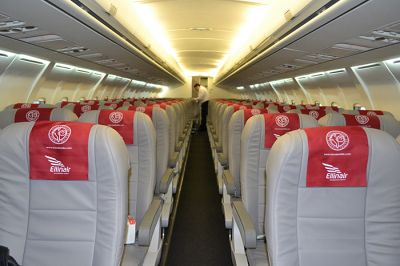More than a piece of plastic

Ellinair SX-EMI interior
By Maroulas.ioannis (Own work) [CC BY-SA 3.0 (http://creativecommons.org/licenses/by-sa/3.0)], via Wikimedia Commons
Passenger comfort is an increasingly important part of the design of aeroplane interiors, and temperature and lighting are critical aspects, particularly on long flights. Novel smart aeroplane windows that adjust lighting and heat will make air travel cosier.
Most smart shading technologies, under intense development in Japan and the United States, rely on expensive processes and are in most cases only compatible with glass substrates. However, aircraft employ plastic windows to achieve important weight reductions.
The EU-funded project 'Innovative bifunctional aircraft window for lighting control to enhance passenger comfort' (IN-LIGHT) is developing a new cost-effective concept based on electrochromism and transparent organic light-emitting diode (TOLED) technology.
Electrochromism is the ability to reversibly change colour in response to a small direct current voltage. Use of electrochromic (EC) technology will allow passengers to control the heat and light entering the cabin by a change from colourless to deeply coloured while maintaining transparency. The TOLED lighting system, also controllable by the passenger, will provide ambient lighting with novel aesthetic effects.
The combination of technologies will enable significant breakthroughs in smart shading concepts. Among these are reduced manufacturing costs, compatibility with plastic substrates, enhanced energy efficiency and performance, and improved switching speed and lifetime.
Nano-structured semiconducting films with anchored chromophores form the basis of the EC technology. Nano-structured layers are typically produced using a sintering process requiring high temperatures that both increase the manufacturing cost and are incompatible with plastic substrates.
The IN-LIGHT high-performance plastic EC aeroplane window employs modified transparent nano-structured electrodes processed at low temperatures. Further cost reductions are achieved through the use of commercially available OLED materials.
Small-scale EC and TOLED prototypes have already been tested and a second series of tests is currently underway. Scientists are now scaling up production and, recently, EC devices and TOLED stacks up to 15 cm x 30 cm- sized were fabricated on a pilot production line using roll-to-roll assembly. Evaluation of environmental, health and safety aspects of the materials and processes is ongoing.
IN-LIGHT will make an important contribution to the competitive position of the EU aircraft industry. Novel products and production processes will lead to less expensive and higher-performing smart shading and dimmable aircraft windows as well as enhanced passenger comfort. In addition, the EC nanoparticle-based formulations represent a significant technological breakthrough. They will facilitate the use of EC technology on plastic for a variety of applications in a broad range of industrial sectors.
published: 2015-04-09

